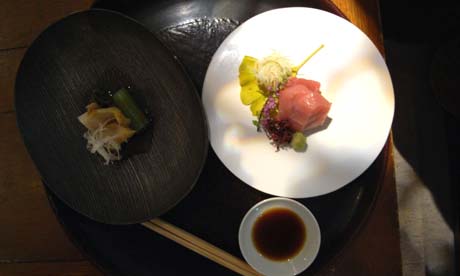
With heavy, well-fed steps, the Michelin man has come to Tokyo. Having previously confined himself to publishing his bible in Europe and the US, next week he launches the first Red Guide to an Asian city. I've witnessed the extreme collywobbles caused to western chefs by Monsieur Michelin, and wonder how the stoic, polite Japanese might react to a downgrading, or an inspector's cutting remark. We'll see. Let's also see some places unlikely to feature in the guide, but where you can feed your spare tyre without bleeding your wallet dry.
What surprises is not that the inspectors have come to Tokyo, but that it's taken them so long. Whether you're at a stand-up sushi bar, slurping a lunchtime bowl of donburi noodles, or enjoying a blow-out meal, Tokyo is a sensational place to eat. For quality, and (surprisingly) value for money, it's hard to beat, even if the scale of the place can be daunting: the metro map looks like the Genome Project, and only major roads have names. Buildings are not numbered consecutively, but by year of their construction, so an address might be: up Tamagawe Dori, left after Cerulean Tower hotel, first right behind Sumitomo building, eighth building on the left - which is where we find Cocoro Soup Curry.
Soup curry is a hot Tokyo trend, and Cocoro, with 17 branches, is curry king. Chicken, pork, seafood or "14 vegetables" soups are offered, along with excellent jazz and a friendly, unbuttoned vibe. You choose from 100 levels of heat (paying extra for levels 50-100, of course) including a bowl of either brown or white rice. This is food that's smooth, deep, spectacularly satisfying and quite distinct from our notions of curry. I've got a long cold beer, a big smile on my face, and a comfortable curry glow.
Next, and equally unlikely to feature chez Michelin, is yakitori. Yakitori joints are for grilled chickeny bits, a few bevvies and a giggle. The best seat you around a counter, with an entertaining chef who acrobatically sprinkles salt on the skewers, and joshes with the punters. Language is irrelevant - you simply grin and point at the display for your next tidbit. I adored Toriyoshi, which has three branches, my favourite found down a tiny, rather unpromising lane off the fashionable track in Meguro-ku. No reservations are taken, so there's some good-natured milling around outside before you're beckoned to join 15 other diners wedged around the low, smoky counter. Ebisu beer is served in chilled ridged earthenware beakers, which keep the head fluffy, and you eat grilled gingko nuts, and just about every part of the super-fresh chicken, followed by a bowl of healing chicken soup my Granny Esther could have made. The locals eat their chicken breast sashimi (raw) here, but point at the grill and they'll sear yours. Many beers on, you leave with your head nicely fluffy.
My friend Bruce, a well-practised Buddhist, teaches that, in Zen, music is about the space between the sound. Thus, the finest Japanese food is about the space between the flavours. This space is filled with the grace of service, the serenity of the surroundings and the beauty on the plate. For all this, visit one of Miyashita's three branches. I went to floor 36 of Marunouchi Building, above Tokyo metro station. This is style with a capital S: a thick, rough-edged maple counter, dramatically lit, with your sushi chef cleanly poised, and a charming barman serving yuzushu - tangerine-infused rice spirit served as a spritzer. High-back chairs; wide views of the living city; tiny tangles of fresh herbs on persimmon jellies; careful hairdos and staccato chatter; slivers of hairy crab in smooth rice; raw tuna that tastes of the tide; seaweed and gold-skinned mackerel garnished with a maple leaf; glistening rice with rare mushrooms; 32 quid for eight courses including drinks. Tokyo shows just how gross restaurant prices have become in London. I've eaten food nearly as good as this at Nobu and other smooth Japanese joints, and been expected to pay £150 a head.
For similar quality, served with unassuming neighbourly wit, get yourself to Issei in Higashi-Shibuya. Ten of you cluster round the counter while chef Masumitsu-san somehow gets you quietly plastered on thimbles of sake. I also got a citrus-marinated oyster swimming in a glass with seaweed puree and sweetened boozy vinegar, followed by many dishes of equally restrained elegance such as tempura of chestnut and saury fish stuffed with shiso leaf. There's subtlety and tremendous artistry at Issei, but no Michelin airs or graces. Lose yourself in the mix of savoury, soft, sweet, bright, crunchy flavours, the quiet clatter of the kitchen, and the bonhomie of the nicely mixed bunch of diners before tripping out, laughing, on sake-light legs.
Way to go
ANA (All Nippon Airways) operates a daily non-stop service from London Heathrow to Tokyo from £482 return (excluding taxes and charges). For further information and reservations contact European Customer Service Centre on 0870 837 8866
Where to eat
Cocoro Soup Curry (03 549 2141, cocoro-soupcurry.com), Shibuya, £10 per head. Toriyoshi Yakitori, Tanitori Building, 2-8-6 Kami Meguro, Meguro-ku (03 716 9644, toriyoshi.org, about £20). Miyashita, 36th floor, 2-4-1 Marunouchi Building, Chiyoda Ku (03 520 3332, ds-miyashita.jp, about £37). Issei, 2-29-6, Higashi-Shibuya, 1st floor, Yamanashi Building (03 346 1716, reservations essential, £35).

